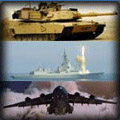2015-07-27 By Ed Timperlake and Robbin Laird
...
Question: We last talked several years ago with regard to the LO materials approach.
How would you characterize progress since that time?

Answer: The durability of signature performance is being validated through numerous mechanisms. One of them is a series of stability over time flights wherein the jets are measured in a dynamic condition. There are a growing number of them, and eventually there’ll be a couple dozen airplanes that get baseline measured with subsequent measurements after so many hundreds of hours, so many calendar months, and so many maintenance events.
Each of the tested aircraft has demonstrated, empirically, that the airplanes have not changed noticeably, or at all.
Despite hundreds, and in some cases as we’re approaching thousands of hours on those airframes, we’re not seeing significant degradation in the system....
Question: Do you see the lessons learned from legacy aircraft so that when the F35 hits the fleet in large numbers, not only are you getting advantage from the additional 2,000 extra hours, but the air frame having the advantage of being designed and built with 21st century materials technologies? 
Answer: We’ve looked at, in detail, design features that have been successful, marginal and unsuccessful on all of our combined Lockheed-Northrop legacy and contemporary programs and done the best job we could balancing all the factors that go into design decisions.
The result, clearly, is the F-35 LO system is an order of magnitude reduction in maintenance compared to all other LO systems. That was our objective; that kind of durability and that kind of supportability, which 21st century materials and manufacturing technologies can provide.
We’re very encouraged by what we see so far.
And the Low Observables Health Assessment System or LOHAS that provides awareness of what the signature maintenance requirements are has been extremely successful too.
We’re seeing ridiculously low LO maintenance burden, almost to the point of questioning credulity by people who see the numbers.
It is amazing how little maintenance the jet requires regarding LO....
Question: You have referred to two parts of your organization, the Materials and Processes or M and P, group and the OML group.
What is the OML group? 
Answer:
OML refers to the Outer Mold Line, the outermost skin line of the airplane.We have two materials and processes organizations on the program. We have the folks that are responsible for the airframe, the structure, and the subsystems. They’re the ones that do the qualifications of subsystems.
They’re the ones that do all the corrosion testing of the black boxes and working with the Vehicle Systems and Airframe Design Teams to make sure that we have an integrated structure that meets the 8,000-hour durability goal.
Then we have our team, which is
Signature Materials and Processes.
We’re responsible for all of the coatings and all the ancillary repair materials and things that go with the coatings.
Everything from the structure out that makes the jet meet its goals from a signature standpoint. The outer mold line spray coating that we have all over the jet is something that the signature materials and processes team is responsible for.
We’re trying to use our qualification testing, our initial evaluation of material systems, in a way that ensures that they have a long life under the wide varieties of environments that we expect the airplane to see.
Then we also recognize that things always happen and even if the material doesn’t intrinsically fail, there’s always a possibility of somebody dropping the tool box or running into the edge of a panel or dropping a cover on the deck of the ship.
Damage is going to happen, so we also have to design, right from the very beginning, compatible repair materials – that work in an operational environment and, in fact, have the same durability as the original materials.
This is maybe a unique point, none of our repair materials are actually repair materials only.
Everything that we use in the field for repair is also used as part of initial production of the airplane, so they’re not limited life repairs. When you make a repair it’s as good as the original and so you don’t have to go back 1,000 hours later or two years later and repair it again because you’ve got some short-term repair material that you’ve slapped on.
Question: You just told us that you really are pre-investing in to less depot maintenance throughout the jet’s service life.
How does the process change because of the pre-investment dynamic? 
Answer:
97% of the LO damage events that occur in an operational environment are unit-level repairable. That’s unprecedented and clearly, reduces depot dependence.
It doesn’t absolutely require depot personnel or depot facilities to affect wide-scale repair of the LO should that be necessary so there’s greater operational flexibility.
The greatest innovations to reduce depot dependence were the manufacture of stealth materials into the structural skins and development of very durable topical materials.
There’s no requirement to strip and recoat our airplane; we’ll just need paint “refresh” like other airplanes.
Our team culture of synergistic cooperation between engineering disciplines, manufacturing, and sustainment is also unprecedented on this program.
Supportable LO, or SLO, is a hybrid organization combining Sustainment and Signature Design that provides a streamline of mutually-shared requirements that improves performance, lowers the cost of manufacturing and translates into availability and affordable stealth.
...

